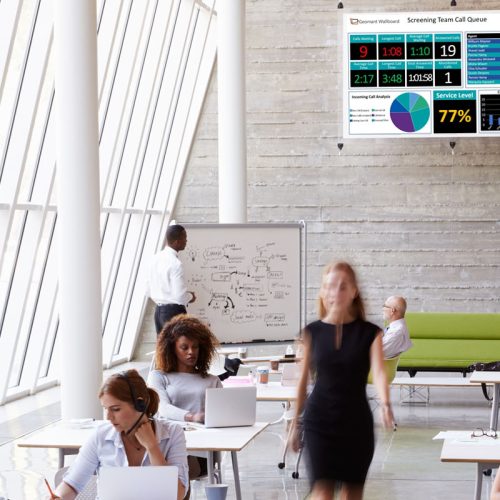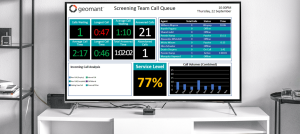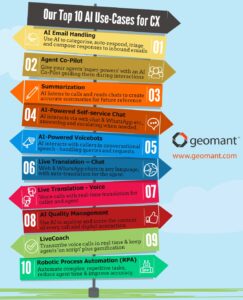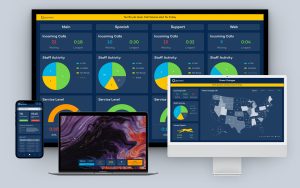If you’re on the hunt for a contact centre solution that can improve agent engagement, give managers the tools to drive success and help boost customer satisfaction, wallboards are a great place to start.
This step-by-step guide to wallboards will walk you through how the technology works, the full range of benefits and the different options out there for you to choose from.
- What are contact centre wallboards?
- When do you need to implement a wallboard solution in your contact centre?
- The benefits of wallboards for contact centre agents
- What wallboard options are out there for you to choose from?
- What contributes to the cost of a wallboard solution?
- Designing an effective wallboard solution
- What other options are available?
- The future of wallboards
What are contact centre wallboards?
The right information at the right time with the right context
Wallboards are digital signage products used by contact centres, customer service departments and help desks, and are used to display information to the agents, supervisors and managers working in them.
This information could include group KPI targets, product or sales information, current trends in queries or issues, data trends, company or policy procedural information, up to date news information and incentive targets. The right blend of information delivered at the right time and with the right context will help staff deliver a high level of service to customers, enabling them to carry out their work efficiently and stay motivated to achieve their targets.
Traditionally, wallboards were LED digital signs, such as the Inova OnAlert M Series, which had outputs in several colours and were easy to read from up to 30 metres away. Modern wallboards display content on a large television screen, desktop PC or tablet. The same information can be sent as threshold-type notifications to mobile phones for supervisors or managers to view when they are away from their work station.
How do contact centre wallboards work?

Put very simply, wallboards take information from various different data sources, aggregate it, consolidate it and display it on a user-friendly large screen in the contact centre. They take the huge amount of data used by and generated by your contact centre and convert it into information that is focused, relevant and actionable.
The visual output from wallboard solutions can also be displayed on agent desktops and supervisor tablets, in alert form on manager and supervisor’s smartphones and as highlights or key statistics displayed in a company lobby or boardroom.
When do you need to implement a wallboard solution in your contact centre?
- When you need to receive critical performance data more quickly.
- If you need to lessen the time agents, supervisors and managers spend trying to find key information.
- To be able to see multiple contact centre and enterprise systems data in single, well-designed view.
- If you want your teams to receive alerts and messages when the department is in danger of failing to reach goals and KPIs.
- If you need to be able to manage information from new channels as well as telephony systems, such as email, instant messaging or live chat.
- If you are seeking to improve the skills of front line managers or support them in being proactive in managing the workforce.
- To help you reduce agent turn-over and absenteeism by keeping agents on track and motivated.
What are the common issues wallboards can solve in the contact centre?
Here are just a few examples of common issues or events that occur in the contact centre that having a well-designed and implemented wallboard solution will flag up and enable supervisors to act on:
- Highlight a critically low number of agents showing ‘available’ status, enabling supervisors to act accordingly.
- Display a downward trend in service levels compared to the previous period (previous day, month) or a previous average.
- Flag up technical information about system outages so that technical help desk agents can react.
- Deliver news of important information or policy changes that may impact the way agents handle contact centre calls.
Let’s take a closer look at the benefits of wallboards for contact centres, the people who work in them and customers and prospects who use them.
The benefits of wallboards for contact centre agents
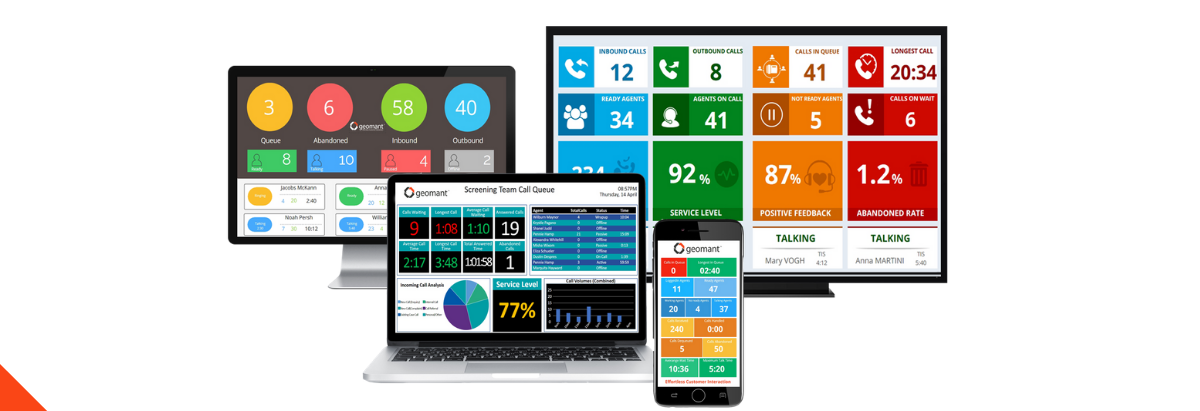
There is a strong link between happy employees and happy customers, and another one between happy customers and profit.” – Bernard Marr
Wallboards are proven to have a positive impact on contact centre agent engagement, productivity, and job satisfaction. Wallboards provide agents and their supervisors with real-time access to a blend of performance data and motivational information, so everyone is able to see and work towards targets. Presenting information in this way means that every single member of the team is working together towards KPIs and can pull together if any metrics are being missed.
Implementing a culture of collaboration and having shared goals helps to support agents working in what can be a stressful environment. Sharing targets and progress also means that agents who work hard will be recognised and agents that underperform will be encouraged to do better.
Wallboards are often designed so that their information is presented with gamification features which is another great way to motivate agents, encouraging them to do their best, beating their previous “high scores”. Gamification helps businesses to foster a culture of friendly competition, which can help to raise the overall standard of work in the contact centre and saving money for the business overall.
Reduce agent absenteeism by up to 9 percent
Wallboards in the contact centre have been shown to reduce agent absenteeism by up to 9 percent. Absent agents will have a direct impact on capacity, so lowering the rate will help take the pressure off and will mean that work is more evenly distributed.
The benefits of wallboards for delivering good customer service
62% of companies perceive customer experience delivered by contact centres as a competitive differentiator. Deloitte
Customer experience is the new battleground for businesses looking for an edge over the competition, and offering timely and helpful customer service in contact centres and helpdesks is key.
Wallboards are an effective tool to help contact centres improve their customer service by giving managers the opportunity to look at how different areas of the business are performing or to pick out trends in complaints and amend their approach or the information they feed to agents appropriately.
With the real-time management capabilities offered by wallboards, contact centre managers are immediately notified when demand changes or the service levels dip. With that knowledge, decision-makers can adjust their strategies to account for evolving situations and ensure consistently excellent service.
Finally, it must be noted that the front line customer service offered by agents is often better if they are happy and knowledgeable. A positive company culture and motivated agents is a key element of customer service.
The benefits of wallboards for contact centre managers and supervisors
The digital transformation of contact centres has been rapid and wide ranging. New communications channels such as instant messaging, online chat and social media are increasingly popular and more commonly used by Millenial and Generation Z consumers.
The introduction of these new inbound channels can greatly complicate the job of managing a contact centre. Supervisors who need to allocate agents and integrate and manage queues find their role is more complex without accurate oversight. The introduction of a wallboard solution makes the omnichannel contact centre far easier to manage. A customisable digital wallboard will keep track of the omnichannel dynamic, with social media, live chat, email and other communication data all factoring into one, single view dashboard.
Our blog on boosting performance in the contact centre with digital signage takes a deeper dive into the motivational and technological benefits of rolling out wallboards in your organisation.
What wallboard options are out there for you to choose from?

Wallboard solutions enable connection and integration with a range of on-premises and cloud-based data sources including:
- Telephony systems (ACD, IVR)
- Unified communications systems
- CRM (customer relationship management) systems
- Intranets
- Newsfeeds
Cloud-based wallboard solutions are an ideal fit for businesses with several locations in one country or a global presence but without an internal private network.
What contributes to the cost of a wallboard solution?
A wallboard is more than just a screen and the data it displays. In addition to the cost of the hardware, there are also a range of licensing, service and optional features to consider that will add up to the final cost of implementing a wallboard solution.
Wallboard licensing costs
- Platform licences are for the core wallboard technology, and most providers offer a perpetual licence for on-premises deployments that gives you access to the software indefinitely. There will also be a monthly support cost to add which is dependant on the service level and coverage required. Cost: the licence will be around £4,000 – £8,000. Support cost 8 hours a day, 5 days a week – 18% of licence cost.
- Display licences are dependant on the functionality of the screen and the size, and are a one-off cost for the lifetime of the display. Cost: £100 – £550 depending on screen size and functionality. Volume discounts tend to apply when more than 10 screens are purchased – the higher the volume the more considerable the discounts are likely to be.
- Connectivity licences join your data with the physical wallboard and given how many data sources there are, the cost of this can vary enormously. The number of agents and queues needed will also bring the cost up or down. Depending on your requirements and the data sources you can select from certified connectivity licences or go for custom source connectivity licences. Cost: certified connectivity licences around £5,000 (assuming a typical number of monitored objects) but can be as low as £2,000 or as high as £15,000.
- Custom source licences £2,000 – £15,000 per data source.
Optional features and services
- Trend analysis software stores the real time data being passed to the wallboard and processes it to create a history which highlights insightful trends and patterns. Cost: approximately £1,500
- Wallboard design consultancy is worth considering, given how important the right data and KPIs are. We go into design in more detail below but if getting it absolutely right first time is crucial, a consultant will be a good investment. Cost: £515 for ½ day of training/consultancy
If you’re on the hunt for more information about this subject, our blog looking at the cost and value of wallboards contains a wealth of useful information and insight to help you decide what you need for your contact centre.
Designing an effective wallboard solution
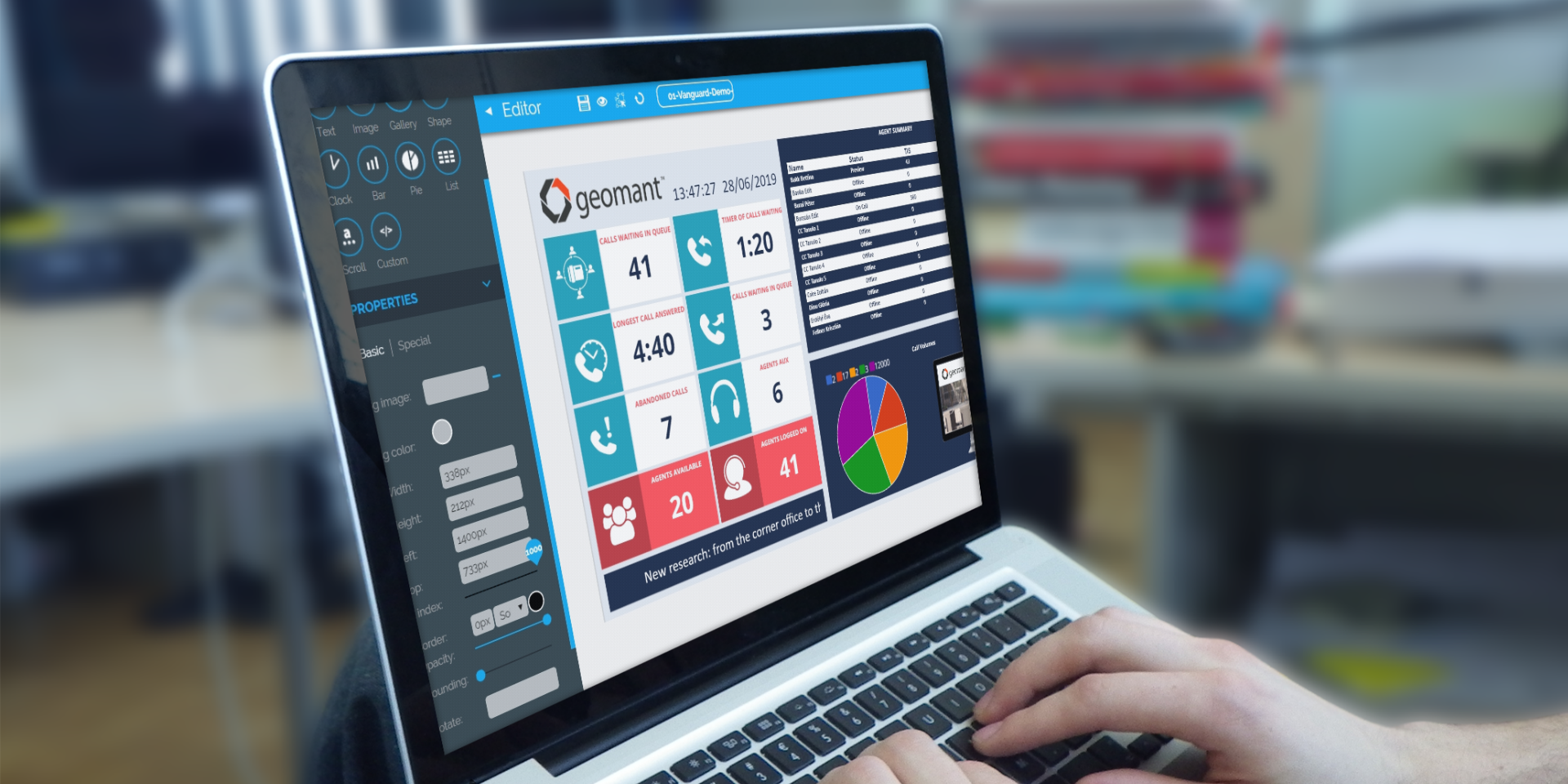
Just like modern website design, the design of wallboard solutions has taken great strides forward in recent years, finding a balance between an appealing interface and clear, user-friendly outputs. Clear communication is the reason wallboards are implemented, so ensuring clarity should be at the heart of wallboard design.
Here are some helpful tips from Geomant’s wallboard experts on how to go about designing the visual output of your wallboard:
- Using bold icons, clear fonts, and colours all help agents understand the key outputs and data at a glance. Avoid complicated fonts and bear in mind the psychological effects of colours. Don’t decide to use red to denote success and green to flag up a problem. Humans are hardwired to see red as a warning colour, there’s a reason why we use the same colours for traffic lights around the world…
- Group data logically so that the agent doesn’t have to spend time scanning the wallboard to find what they need. The most important metrics should be bold and ‘pop’ from the screen.
- Display the key KPIs that are relevant for each team at the right time. If key targets change throughout the day then make sure this is reflected in wallboard design. In addition, if teams need different information why not have bespoke outputs for them with only the information they need?
- Don’t be afraid of white space – effective use of white space increases comprehension by almost 20% (Human Factor International).
If you’ve been tasked with implementing a wallboard solution for your contact centre then our blog on the subject is a must-read.
Wallboard custom integrations and services
If your contact centre uses a complex hybrid system from several vendors (for example Avaya, Cisco, Genesys or Aspect) or has multiple products for different areas (inbound, outbound and multimedia) you may need to seek assistance from a specialist systems integrator to help you set up and manage a wallboard solution.
Geomant works closely with businesses of all types, sizes and sectors to guide them in their journey to implementing wallboard technology in their contact centre. Find out more on our Wallboard Services page.
What are the other options available?
Not sure about wallboards for your contact centre or helpdesk? You can source similar information by exporting reports from telephony and/or CRM systems, but with one crucial difference.
If you export a report from a telephony system it will give you an accurate snapshot of activity and performance – but it is only a snapshot of static data. It means that anything that changes once the report has been produced isn’t captured and your supervisors and agents won’t have real-time information
Get set for success – how to select the correct outputs and KPIs for your operation
Today’s sophisticated omnichannel technology and the detailed reporting on offer have made it possible for contact centre managers to measure a vast number of metrics. They can then analyse them in myriad ways to aid decision making and strategy. So how can you make sure you have the bandwidth to choose the right data and KPIs for you contact centre?
Less is more
Contact centre agents are busy and they have multiple sources of information to manage at any given time – their own dashboard or telephony system, the voice of the caller in their ear and feedback from a supervisor. Add a wallboard to the mix and, even with the aim of helping to motivate them, it could easily overwhelm them. It’s important to keep it simple and only display the metrics that really matter. Keep text and messages short and concise and outputs clear.
Reflect on your objectives
Business objectives are the high-level goals for an initiative and are often defined by the management team before they invest in a project. The project aims will usually be around increasing profitability, reducing costs, improving customer satisfaction or adhering to compliance mandates etc. Metrics are the measurements that support the business objectives. For instance, If you want to increase your profit margin, the metric that matters here will be the formula that defines profitability.
Create a list of project goals and show their related objectives and associated KPI’s and then use them wisely to keep your organisation on course.

Speak to your agents and supervisors
If you are trying to set meaningful and effective KPIs for your contact centre, they must be easily understood by employees as well as supervisors and management. KPIs should remain an integral part of agents thought process when interacting with customers, especially when you’re trying to increase performance.
Agent performance KPIs measure the performance of help desk agents by tracking how they perform on key metrics, such as number of calls handled, first-call resolution, and customer satisfaction. Weaving gamification into KPI tracking will help agents stay motivated and driven to succeed. Gamification, in the context of help desks, is used to track individual agent performance by assigning agents points for tasks completed. For example, some systems will assign points to an agent for responding to a ticket in a certain amount of time or for getting positive feedback from a customer.
We’ve gone into more detail on the setting and implementation of KPIs in the contact centre in our insightful blog.
The future of wallboards
As new technologies change the way people live their daily lives there is a knock-on effect on the information businesses need in order to serve them effectively. The data produced will likely come from new sources and communication channels that we don’t yet know the shape of. Here are some predictions from our wallboard product experts:
The digital transformation of the contact centre will continue: We predict that wallboards will be used more and more by new digital platforms (chat engines, IM platforms, IM aggregators, sales automation tools, ERPs) in the same way the traditional call based ACD uses them today.
High performance middleware will open the door to greater things: Wallboards of the future will be using high performance middlewares capable of managing and working with large data sets and providing enhanced alerting mechanisms through integration with smart wearables and 3rd party apps.
The internet of things (IoT): Customer connected Internet of Things devices (for example connected fridges or cars) will feed data to contact centres. Wallboards will play an important role in displaying relevant aggregated data coming in from smart devices and helping customer service centres and tech support teams manage capacity.
As the communications channels that act as data sources change and evolve, so will the KPIs that need to be measured to ensure the contact centre is operating effectively. Here’s an insightful blog looking at the evolution of the ‘right’ contact centre metrics.
Looking for more information on wallboard solutions for contact centres?
Our comprehensive eBook ‘Wallboards for Social Housing’ takes a look at the subject for the not-for-profit housing association sector, but there is plenty of great information there that’s transferable to any sector.
You can also speak to Geomant’s wallboard team and book a personalised demo to find out the range of benefits of a wallboard solution for your business.
